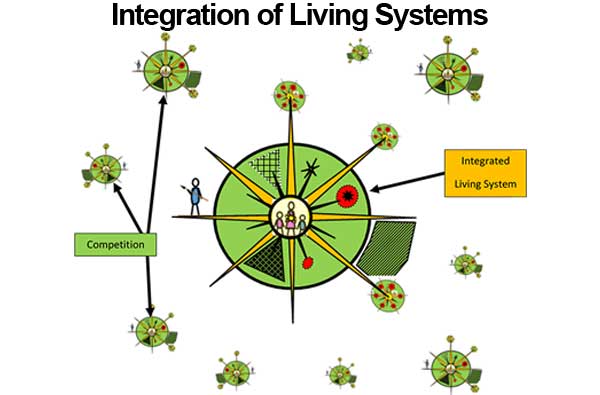 P.O. Box 941120 , Maitland , FL 32794-1120
P.O. Box 941120 , Maitland , FL 32794-1120 dmarks@cfl.rr.com
dmarks@cfl.rr.com  407.694.7040
407.694.7040
Like a gardener tending a plot of land, living systems perform work by taking control and organizing their environment.
Below is a conceptual diagram of a living system that is surrounded by smaller living systems. It looks like a small family farm, carrying out the processes of life. A male is protecting it and a female is caring for their offspring. This life force has incorporated some smaller life forces, creating a small community. It could grow and develop into a larger community or into a company. It functions within a larger food web or economy. Each of these living systems is integrated with its control center, a brain. They have a program or goal that they are trying to reach. But in the case of the larger food web there is no integration or control center. These living systems are separate forces that are competing for survival.

Below are four examples of life forms taking control of their environment. A cell controls and organizes its internal environment so it can carry out its function. An organism such as a spider controls its internal systems, and monitors its web to catch food. A rural community, with a village core, uses much of its territory for farming and livestock, to produce its required food supply. A region, such as Atlanta, organizes its transportation system so it can efficiently distribute goods and services within its area.
In all these cases, these living systems preform work in their environment to reach their goals. The cell performs its required processes, the spider captures food, and the community creates a society and economy that represents it values, and how it wants to live. The Atlanta region creates infrastructure that connects the area’s communities.
Distance seems to be a significant factor in how much control and order a system has. As these living systems get larger in scale, central control is weakened. For example, the Atlanta region functions more like a food web, or economy, with little central control. Care is also reduced by distance. A small community can provide more care while a region will be dominated with rules.

Domestication is like gardening, it is the process of humans caring for wild plants and animals, integrating them into their community, for our use. Man, also seems to have been domesticated, bringing him in from the wilderness to urban centers. Domestication uses the female qualities of care and integration.
The type of environment a life force is immersed in will have a major impact on its development. Cats and dogs that have been domesticated, brought up in loving households, are very different than cats and dogs that live in the wild. Wild cats and dogs are much more aggressive. These two environments create two very different world views for these life forms. This also applies to people. If you bring people up in an impoverished environment with lots of danger, how is this setting going to shape their worldview? To cope with this stressed environment, they are going to become aggressive, or they are going to retreat to protect themselves.
A healthy family and community creates an environment of care that protects and nurtures their children. Humans can become caring or aggressive, largely based on the environment that we are raised in. We take on the characteristics of our environment.
Read Chapter 7: Food Chain and Food Web – A Dog Eat Dog World